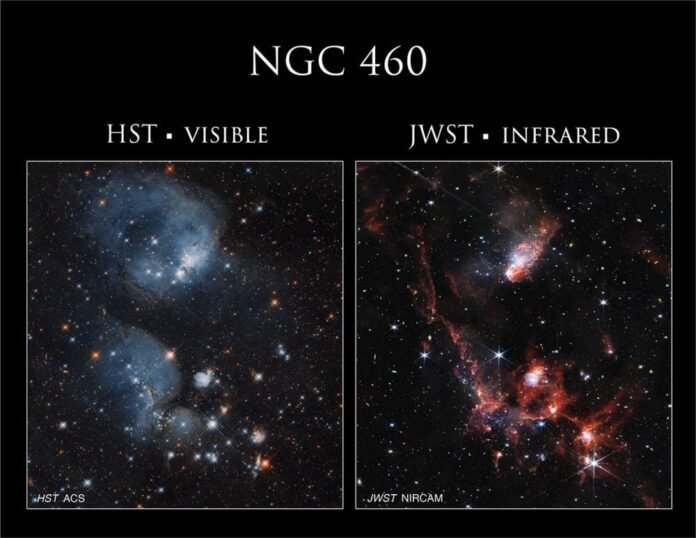The Hubble Space Telescope is one of the most successful scientific endeavours in history, maybe the most successful. It’s been observing the heavens for more than 35 years since its launch in 1990. The JWST is the most powerful and complex space telescope ever built, and has been expanding our horizons since its launch in December, 2021. When working together, they create synergy that not only benefits science, but provides stunning images of the cosmos.
The pair of telescopes combined their power to create composite images of two open star clusters in the Small Magellanic Cloud. NGC 460 and NGC 456 both have nebula, and they’re both dazzling examples of how matter and energy interact to create natural spectacles.
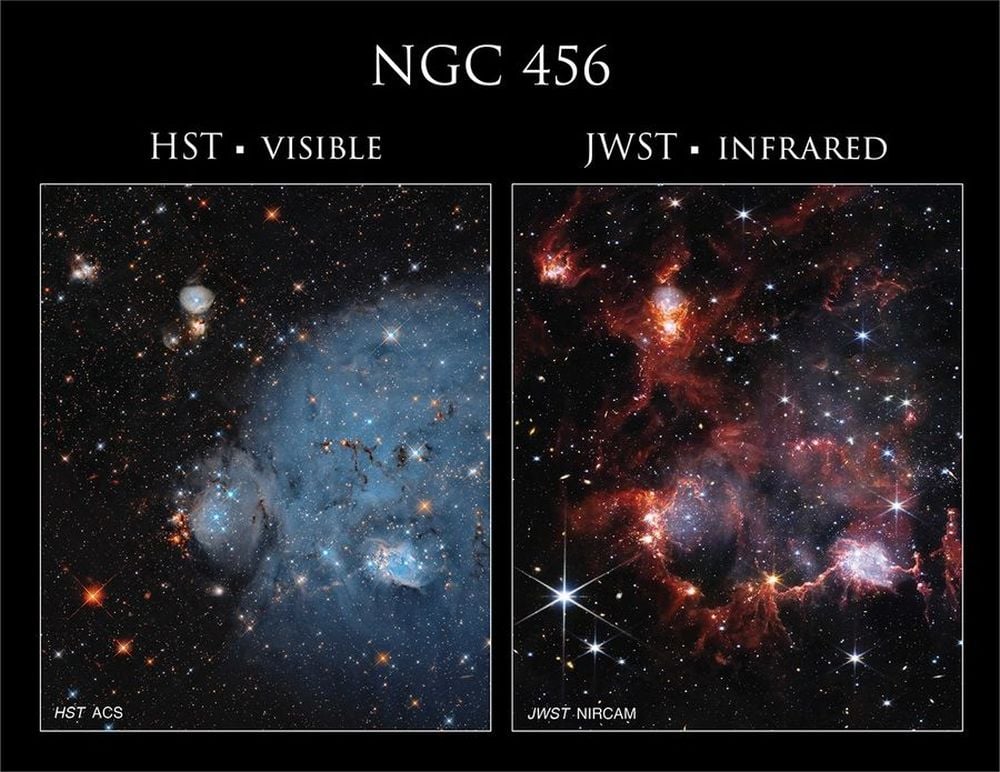 Side-by-side images of NGC 456 by the Hubble and the JWST highlight the differences between the two telescopes. The image from Hubble’s Advanced Camera for Surveys, its primary imaging instrument. It covers from the Ultraviolet range to the near-infrared regions and highlights a puffy cloud of ionized gas in blue. The image from the JWST’s NIRCam instrument shows that dust that outlines those clouds. Image Credit: NASA, ESA, and C. Lindberg (The Johns Hopkins University); Processing: Gladys Kober (NASA/Catholic University of America)
Side-by-side images of NGC 456 by the Hubble and the JWST highlight the differences between the two telescopes. The image from Hubble’s Advanced Camera for Surveys, its primary imaging instrument. It covers from the Ultraviolet range to the near-infrared regions and highlights a puffy cloud of ionized gas in blue. The image from the JWST’s NIRCam instrument shows that dust that outlines those clouds. Image Credit: NASA, ESA, and C. Lindberg (The Johns Hopkins University); Processing: Gladys Kober (NASA/Catholic University of America)
Astronomers are interested in the Small Magellanic Cloud because of its low metallicity. Its low metallicity makes it similar to the early Universe, before enough massive stars had lived and died to generate heavy elements and spread them throughout the cosmos. For this reason, the SMC is like a nearby laboratory where astronomers can observe what the ancient Universe was like and study how star formation occurred in the ancient interstellar medium.
While side-by-side images are instructive, the real power of the telescopes is brought to bear on their composite images.
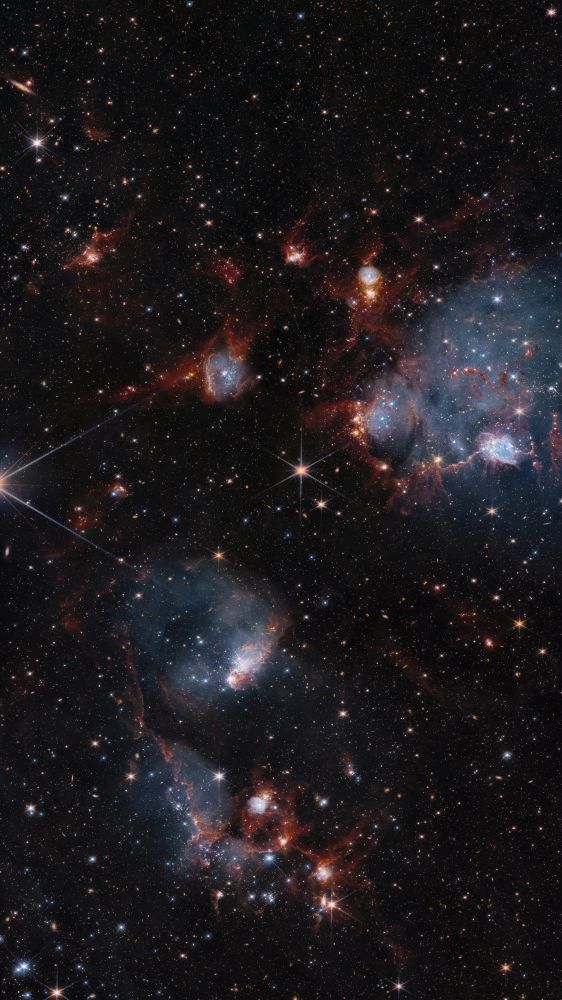 NGC 460 and NGC 456 appear side by side in this Hubble/JWST composite image. They’re part of a large complex of nebulae and star clusters whose origins are likely linked. This highly detailed 527 megapixel mosaic consists of 12 overlapping observations and includes both visible and infrared wavelengths. Image Credit: NASA, ESA, and C. Lindberg (The Johns Hopkins University); Processing: Gladys Kober (NASA/Catholic University of America)
NGC 460 and NGC 456 appear side by side in this Hubble/JWST composite image. They’re part of a large complex of nebulae and star clusters whose origins are likely linked. This highly detailed 527 megapixel mosaic consists of 12 overlapping observations and includes both visible and infrared wavelengths. Image Credit: NASA, ESA, and C. Lindberg (The Johns Hopkins University); Processing: Gladys Kober (NASA/Catholic University of America)
Stars form in these clusters when massive gas clouds collapse and form stellar cores. Over time, they accrete more mass and eventually fusion is triggered. That’s when they begin their lives of hydrogen fusion. These young hot stars expel powerful radiation that can carve bubbles or caverns in the gas. Their powerful winds can also trigger the collapse of more stellar cores, leading to more star formation.
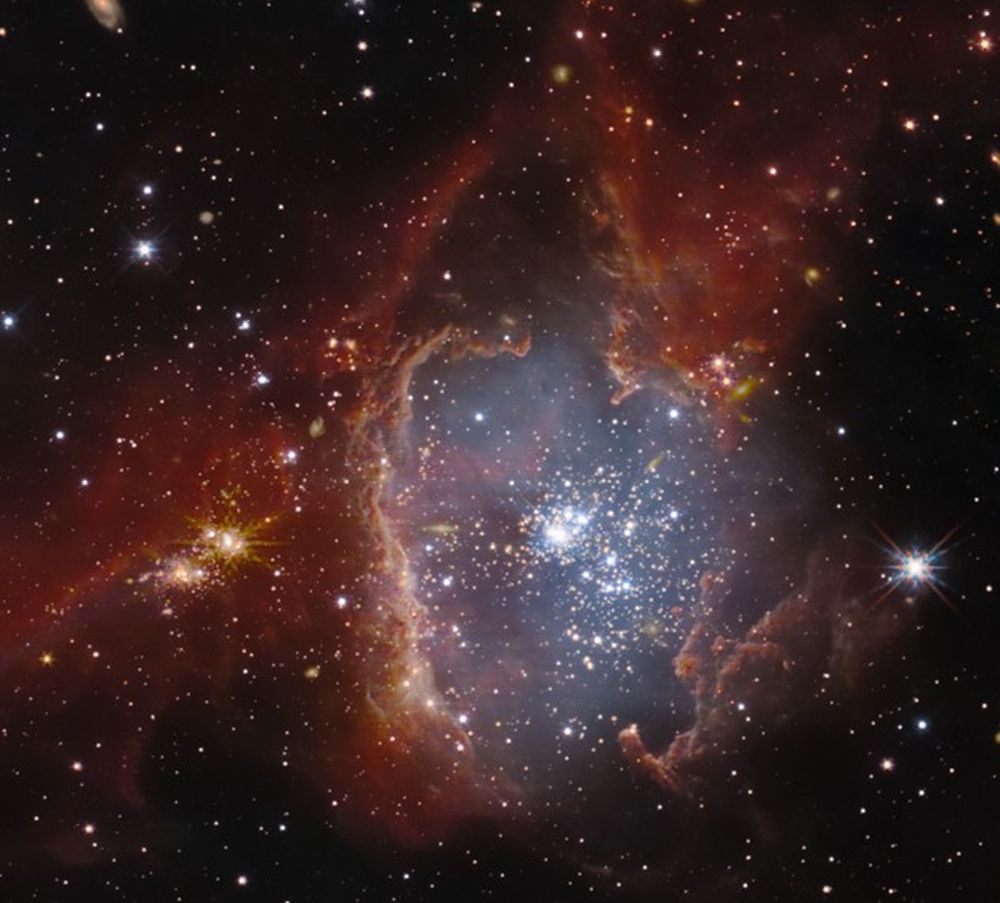 A zoomed-in portion of NGC 460. Image Credit: NASA, ESA, and C. Lindberg (The Johns Hopkins University); Processing: Gladys Kober (NASA/Catholic University of America)
A zoomed-in portion of NGC 460. Image Credit: NASA, ESA, and C. Lindberg (The Johns Hopkins University); Processing: Gladys Kober (NASA/Catholic University of America)
The Hubble’s view captures glowing, ionized gas as the stellar radiation blows bubbles in the clouds of gas and dust, seen in blue. The Webb’s powerful infrared vision highlights clumps and delicate filamentary structures of dust seen in red. In Hubble images, dust is often seen silhouetted against and blocking light. But the Webb’s infrared vision lets it see the dust shine with its own infrared glow as its warmed by stars. The mixture of gas and dust between stars constitutes the interstellar medium.
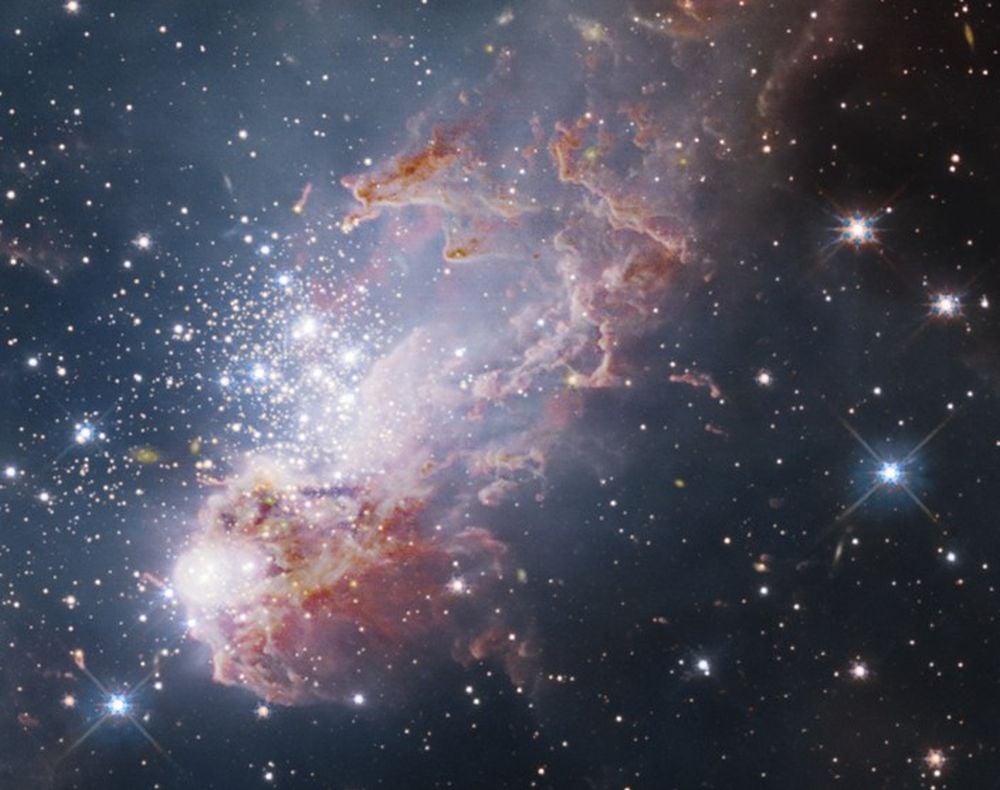 A zoomed-in portion of NGC 456. Image Credit: NASA, ESA, and C. Lindberg (The Johns Hopkins University); Processing: Gladys Kober (NASA/Catholic University of America
A zoomed-in portion of NGC 456. Image Credit: NASA, ESA, and C. Lindberg (The Johns Hopkins University); Processing: Gladys Kober (NASA/Catholic University of America
The stars in these images are young, mostly between 1 and 10 million years old, compared to our Sun’s 4.5 billion year age. The pair of clusters are part of a larger complex of star formation with the bureaucratic-sounding name N83-84-85. It’s in the inner wing of the SMC, and the structure contains many OB stars.
These are hot and massive stars that often form in groups, called OB associations. Many of the OB stars will explode as supernovae and many already have. They’re responsible for stirring up the ISM in the region, creating some of the artful shapes and triggering more star birth. By observing this process in the SMC, astronomers are getting a glimpse of what the early Universe was like. They focus on it because it shows the feedback between OB star formation and the interstellar medium’s physical properties.
Anyone can download this huge image and zoom-in and explore it until they lose track of time. You can find it here.


